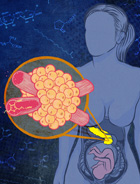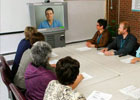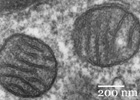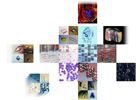 As UHN's monthly research newsletter, NRx reports on the full spectrum of leading research from UHN's five research institutes. Located in downtown Toronto, these institutes are the Princess Margaret (PM) Cancer Centre, the Toronto General Research Institute (TGRI), the Toronto Western Research Institute (TWRI), the Toronto Rehabilitation Institute (TRI) and the Techna Institute (Techna).
As UHN's monthly research newsletter, NRx reports on the full spectrum of leading research from UHN's five research institutes. Located in downtown Toronto, these institutes are the Princess Margaret (PM) Cancer Centre, the Toronto General Research Institute (TGRI), the Toronto Western Research Institute (TWRI), the Toronto Rehabilitation Institute (TRI) and the Techna Institute (Techna).
In this issue you can read about:
- A more effective cure for hepatitis C
- Preventing type 2 diabetes after pregnancy
- How cancer may trigger a rare type of encephalitis
- Using telehealth to promote disease self-management
- Clues on how cells get big
- Cutting edge research facilities at UHN
We hope that you will find NRx informative. If you have feedback or questions, please contact www@uhnresearch.ca.
Christopher J. Paige, PhD, FCAHS
Vice President, Research
University Health Network

This new therapeutic regimen comprises five different medications that prevent the virus from multiplying within the liver.
Over 180 million people worldwide are infected with the hepatitis C virus (HCV). The virus damages the liver, an essential organ needed for the removal of toxins from the body, the digestion of food and the storage of nutrients. HCV causes progressive liver damage over many years that can lead to liver cirrhosis and ultimately liver failure or liver cancer. HCV infections are concurrently treated with a combination of medications prescribed for up to a year that can cause serious side effects and have relatively low cure rates. TGRI Scientist Dr. Jordan Feld led a study investigating a promising new therapeutic regimen to treat HCV infections that was published in The New England Journal of Medicine.
The study enrolled over 600 patients infected with HCV at sites across North America, Australia and Europe. Participants received either the new therapeutic regimen or a placebo—a pill containing no medicine—for 12 weeks. Overall 96% of patients treated with the new regimen were cured of their infection and the pills were very well-tolerated with only mild side effects.
Researchers found that the new therapeutic regimen led to higher cure rates than conventional HCV treatments and caused significantly fewer side effects, enabling more patients to complete their treatment. This new therapeutic regimen, along with others in development, has the potential to save lives by decreasing the prevalence of HCV and its associated complications.
This work was supported by AbbVie and the Toronto General & Western Hospital Foundation.
Treatment of HCV with ABT-450/r-ombitasvir and dasabuvir with ribavirin. Feld JJ, Kowdley KV, Coakley E, Sigal S, Nelson DR, Crawford D, Weiland O, Aguilar H, Xiong J, Pilot-Matias T, Dasilva-Tillmann B, Larsen L, Podsadecki T, Bernstein B. New England Journal of Medicine. 2014 April 10. [Pubmed abstract]

Approximately 3-14% of all women will develop gestational diabetes during pregnancy.
Some women develop gestational diabetes during pregnancy. As a consequence, they are unable to produce sufficient levels of insulin to control their blood sugar levels. This type of diabetes often precedes the development of type 2 diabetes later in life.
A new research study led by TGRI Senior Scientist Dr. Michael Wheeler addresses this health concern by identifying a metabolite—a small molecule produced in the body—that may indicate risk of developing gestational diabetes.
In the study, which was published in the journal Cell Metabolism, researchers measured the levels of different metabolites in blood samples taken from patients without diabetes and compared them to those from patients with type 2 diabetes and gestational diabetes. These comparisons revealed that patients with gestational diabetes and type 2 diabetes have markedly higher levels of an unusual metabolite known as CMPF (3-carboxy-4-methyl-5-propyl-2-furanpropanoic acid). Subsequent studies by the team demonstrated that CMPF inhibits insulin production and release, whereas application of an antioxidant or blockage of CMPF entry into cells inhibited CMPF activity and restored the level of insulin secretion.
"Based on our findings we believe that CMPF and its transporter represent novel targets for prevention and treatment of gestational and type 2 diabetes", says first author Kacey Prentice. "If we can reduce levels of CMPF in the blood, or prevent its activity through blocking its entry or with antioxidant treatment, we believe that we can preserve insulin production and thus slow or prevent diabetes."
This work was supported by the Canadian Institutes of Health Research, the Canadian Diabetes Association, the Canadian Foundation for Innovation, the Ontario Ministry of Research and Innovation and The Toronto Western & General Hospital Foundation.
The furan fatty acid metabolite CMPF is elevated in diabetes and induces β cell dysfunction. Prentice KJ, Luu L, Allister EM, Liu Y, Jun LS, Sloop KW, Hardy AB, Wei L, Jia W, Fantus IG, Sweet DH, Sweeney G, Retnakaran R, Dai FF, Wheeler MB. Cell Metabolism. 2014 April 1. [Pubmed abstract]

Autoimmune diseases occur more often in women than men and symptoms often start during childbearing years.
A teratoma is a type of cancer that can produce various cells and tissues, leading to formation of hair, teeth and sometimes organs and brain tissues within the tumours. Typically benign, these tumours can be removed and rarely lead to complications; however, recent observations have linked these cancers, when they occur in ovaries, with the development of NMDAR (N-methyl-D-aspartate receptor) encephalitis—a potentially serious autoimmune condition in which the patient's own immune system attacks healthy brain tissue.
Patients with NMDAR encephalitis experience debilitating neurological symptoms that include "loss of reality", psychosis, memory defects, seizures and irregular vital signs. While it is currently unknown how this condition arises, a recent article published in JAMA Neurology provides the first observable link explaining how ovarian teratomas may lead to the development of this condition.
The collaborative research team, which included TWRI Clinical Researcher Dr. David Tang-Wai, UT's Dr. Gregory Day and neuropathologists at Saint Michael's Hospital, found brain tissues growing in ovarian teratomas excised from patients with encephalitis. These tissues included abnormal neurons that appeared to be surrounded by cells of the immune system, suggesting that they may be serving as a trigger for the immune system to target neurons in normal brain tissues. Abnormal neurons were not seen in ovarian teratomas resected from individuals who did not have NMDAR encephalitis.
While preliminary, these findings suggest that visual inspection of ovarian teratomas for the presence of irregular neurons may provide physicians with a valuable tool to identify those at risk of developing autoimmune encephalitis.
This research was supported by direct donations from patients and families and by the Toronto General & Western Foundation.
Abnormal neurons in teratomas in NMDAR encephalitis. Day GS, Laiq S, Tang-Wai DF, Munoz DG. JAMA Neurology. 2014 April 28. [Link to Article]

Two-way telehealth video connections allow for discussion and the sharing of stories, and do not limit participation to those who cannot read.
Helping people to self-manage their chronic illnesses has the potential to relieve pressure on the health care system and improve quality of life for patients. However, optimal self-management is often difficult for patients to achieve on their own—a problem addressed by the development of self-management education programs. To explore the impact of these programs in rural communities, TRI Senior Scientist Dr. Susan Jaglal evaluated a chronic disease self-management program (CDSMP) delivered in partnership with the Ontario Telemedicine Network (OTN) to patients with heart disease, stroke, lung disease or arthritis.
Because the need for self-management training programs is greatest in rural and remote areas with limited access to health care services, leaders were trained by the CDSMP to support patients in small communities (those with fewer than 20,000 inhabitants). Dr. Jaglal and her collaborators found that the telehealth CDSMP sessions were effective in helping people to better self-manage their conditions and to minimize the negative impact of symptoms on daily activities. Participants in the program also increased healthy behaviours, such as exercise, and reported improved physician-patient communication.
"Using telehealth to facilitate these peer-led education programs overcomes important barriers to health delivery in smaller, remote communities. Our findings show that this at-a-distance training program is highly effective and comparable to in-person training," says Dr. Jaglal.
Supported by the Canadian Institutes of Health Research, the Ontario Telemedicine Network, the Heart and Stroke Foundation and the Toronto Rehab Foundation. W Lou holds a Tier 2 Canada Research Chair in Statistical Methods for Health Care. Image courtesy OTN.
Increasing access to chronic disease self-management programs in rural and remote communities using telehealth. Jaglal SB, Haroun VA, Salbach NM, Hawker G, Voth J, Lou W, Kontos P, Cameron JE, Cockerill R, Bereket T. Telemedicine Journal and e-Health. 2013 Jun. [Pubmed abstract]

Mitochondria (above) are the special organs inside cells that provide energy to fuel cellular functions and activities.
The human body is made up of various organs and tissues that are composed of billions of cells of different shapes and sizes. While cells tend to be a certain size that is specific to their type, they are often larger in metabolically active organs (including the heart), during certain stages of cell maturation and during wound healing. Such observations suggest that cells have mechanisms to control their size according to their specific circumstances, but very little is known about how this occurs. A recent study from PM Cancer Centre Senior Scientist Dr. Tak Mak and his team reveals new information that sheds light on this mystery.
The team conducted a novel genetic screen to look for genes that control cell size and identified Largen—the product of a gene that increases cell size when overexpressed in human cells. Further examination showed that Largen stimulates the production of specific proteins that increase mitochondrial respiration, the process by which cells generate energy to fuel activity.
"Largen overexpression may accelerate a process that produces more energy in a cell, which provides fuel for protein production and leads to an increase in cell size," says Dr. Mak. "Further studies are required to dissect the molecular details of how exactly Largen controls these phenomena."
This study was supported by the Canadian Institutes of Health Research, in part by the Ontario Ministry of Health and Long-Term Care, and The Princess Margaret Cancer Foundation. T Mak is a Tier 1 Canada Research Chair in Inflammation Responses and Traumatic Injury. M Ikura is a Tier 1 Canada Research Chair in Cancer Structural Biology.
Largen: a molecular regulator of mammalian cell size control. Yamamoto K, Gandin V, Sasaki M, McCracken S, Li W, Silvester JL, Elia AJ, Wang F, Wakutani Y, Alexandrova R, Oo YD, Mullen PJ, Inoue S, Itsumi M, Lapin V, Haight J, Wakeham A, Shahinian A, Ikura M, Topisirovic I, Sonenberg N, Mak TW. Molecular Cell. 2014 Mar 20. [Pubmed abstract]

UHN provides an array of state-of-the-art equipment and technical expertise to support research. An extensive list of these resources can be found within the updated UHN Facility Information Sheets, which are now available online.
This PDF document provides key details on each facility, including the list of equipment and services available, usage arrangements, location and current contact information.
With 19 different facilities available, these world-class resources include equipment for cell, molecular and structural biology; cell and tissue imaging; genomics; flow cytometry; drug discovery; and medical imaging for clinical/preclinical applications.
To explore these facilities, click here.
 TGRI Senior Scientist Dr.
TGRI Senior Scientist Dr.  TRI Scientist Dr.
TRI Scientist Dr.